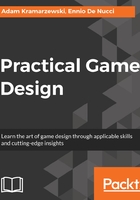
What is a game concept?
Imagine a game that you have played from beginning to end or one that you have simply loved and played for a long time. Would you be able to write a two-to-five pages short presentation on that game? A presentation that describes why is it fun, how you play it, what it looks like, and for what kind of player it is going to be a great experience?
Now imagine that you've never played that game, that it doesn't even exist yet. Would you still be able to describe it?
That vision is the game you want to make and the presentation is a game concept.
The purpose of the game concept is to describe a game with enough detail to distill and communicate its vision to the reader. To explain what makes it fun, who'll enjoy playing it, and why we should make it a reality.
One of the main responsibilities of every game designer is to make sure that, at every stage of development, the vision behind the game is clearly documented and communicated to the team.
As one of the very first steps in the development process, the game concept is the most abstract document, so it is paramount that it stays focused on the core aspects of the game.
After all, you only have a few pages to describe the whole thing. You don't really want to linger on your main protagonist's story for four pages and then describe how the game works in the remaining few lines of the last page.
A game concept is a holistic view of the game; it describes the game and what the team is going to put into it (not just the designers; it contains early artwork and technical and marketing information):
Exercise
This is your first exercise. If you have a game idea already in your head, try to put it on paper: a couple of pages would be enough. If you don't have any particular game idea in mind, try to describe a game that you have played and loved enough to know all its rules and secrets.
There's no need to read the rest of Chapter 1, Introducing the Game Production Process. Do the exercise now, before knowing anything more.
Once this is done, keep going with the reading and the exercises. You will be able to compare your initial work with what we're going to see, expand it, and find and correct any eventual mistake by yourself.
Structure of a game concept document So, how do you write a game concept? And what do you need before starting?
There is some information that any game concept should always contain:
- Introduction (sometimes called a hook or elevator pitch)
- Description/game overview
- A list of key features, including its Unique Selling Points (USPs)
- Game genre
- Platform
- Target audience
It is clear from this list that your role as a game designer is not about deciding all this. The game idea or hook may come from any other team member, from an external client, from a publisher, or from some lead/director within the company.
The games industry offers a lot of freedom and possibilities; there are companies that make games to make a profit or indie developers that follow their passion and make their games because they have something to say—there are even people working on games in their free time just because they love it.
Regardless of the motivations or the goals of a developer, it's always a good idea to treat a game such as a commercial product. This means that, in order to justify the existence of the game, there must be people willing to buy it, play it, and hopefully even talk about it. This is why the game concept needs to go beyond a simple description of a game; you have to think about a game concept as a sales tool.
The audience may vary (and so do the formality and the structure of the document) but the goal stays the same: whoever reads the document must understand and see what the development team wants to do, and needs to get excited about that!
The reader might be a publisher to which you are presenting the idea. Presenting really means selling, in this case. But the reader could be the programmer who is going to implement the game or an artist who is going to create all the artwork or graphical assets, or even just a possible player. All these people will look at the document in a different way, but one thing is for sure: if they get what the document is trying to present they will get excited about the project and look forward to whatever it is they have an interest in, from giving the money needed for its development, to working on it or to just playing it!
Exercise
Try to compare the work you have done in your first exercise with what you have learned in this paragraph. Does your concept include information such as genre, platform, or target audience?
Read on to understand what are we talking about and why these things are as important as the mere description of the game.